The ultimate bed bug guide
Bed Bug Facts
- A female bed bug will lay 1 - 5 eggs per day - around 500 eggs in a lifetime.
- Their ideal breeding temperature is 70 - 85F.
- Eggs hatch in 6-17 days.
- The newly hatched bugs will mature into adults in 6 - 8 weeks.
- Bed bugs reproduce quickly. After bringing a bed bug into your home you can have up to 1,000 after just 70 days.
- The population will double every 16 days. In 6 months you will have multiple generations and up to 100,000 bed bugs.
- Bed bugs can hide dormant without feeding for up to 18 months. This is why sleeping in a different bed or sitting in a different chair will not solve the problem and usually makes it worse because bed bugs hitchhike or crawl to you.
- Bed bugs are drawn to the carbon dioxide in your breath, movement, and warmth.
- Bed bugs prefer humans but can feed on cats, dogs, birds, and rodents.
- There is no evidence that bed bugs spread disease, however they can cause an allergic reaction that can become infected.
Bed Bug Myths
- Bed bugs do not live in your hair or under your skin.
- Bed bugs do not fly or jump.
- Getting bed bugs has nothing to do with how clean your homes is, however clutter will provide more hiding places making extermination more difficult.
- It is possible to eliminate bed bugs, however most people need professional help.
Identification
What do Bed Bugs Look Like?
It is important to verify you have bed bugs before treatment so your exterminator can use the right pesticide. Sometimes people assume they have bed bugs after they are bit. Bed bug bites are an allergic reaction and can appear nearly identical to other insect bites, or even allergic reactions to things like laundry soap. Some people can be bit and not even know it.
Bed Bugs are small reddish-brown bugs 1/8" to 3/16" in size - about the same size as an apple seed. If you can send a clear photo, your exterminator can identify the bug and save you the cost and time of having an inspection.
Bed Bug Life Cycle:
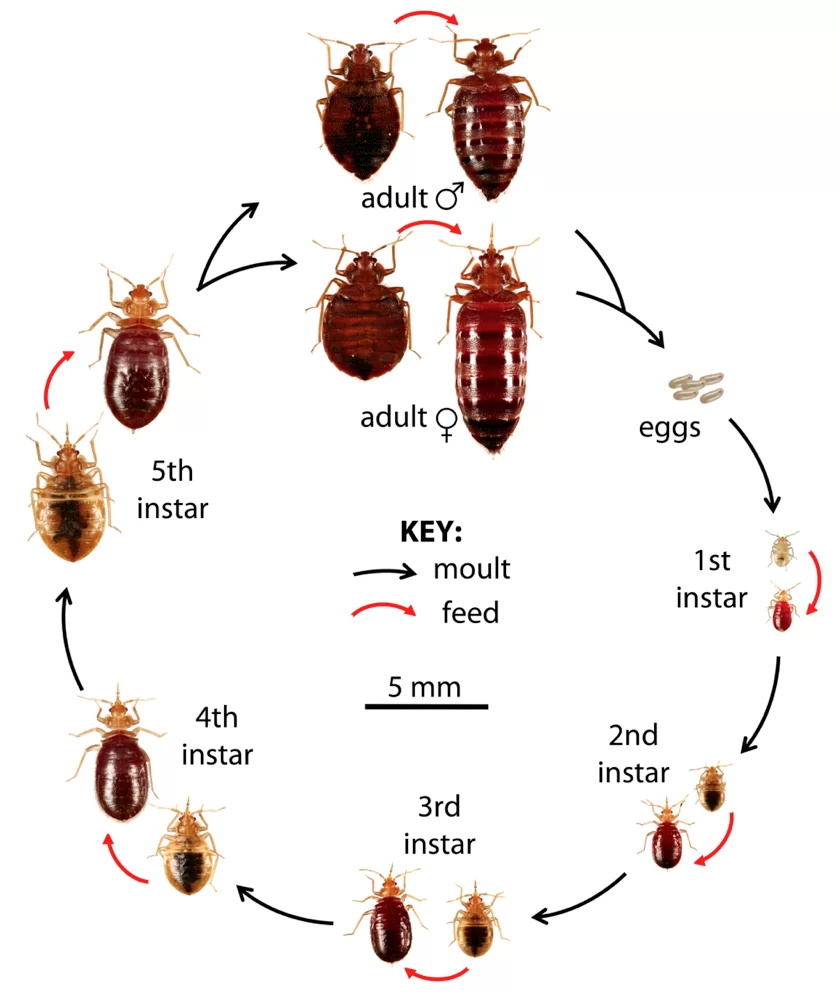
Adult Bed Bug:
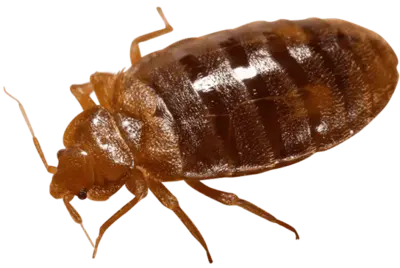
Common Bugs Mistaken for Bed Bugs:
Sometimes other bugs are confused as bed bugs. Below are examples of photos of bugs that are not bed bugs.
Roach Nymph:
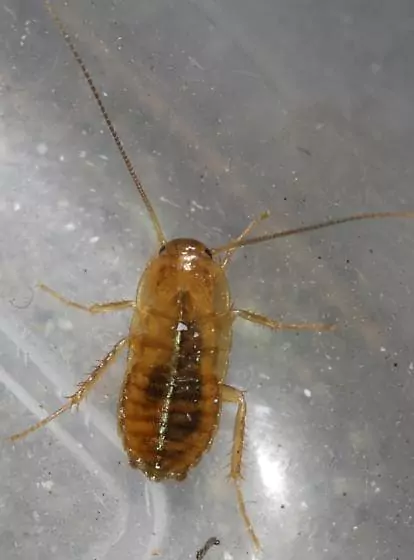
Flea:
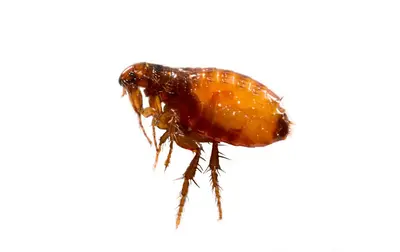
Carpet Beetle:
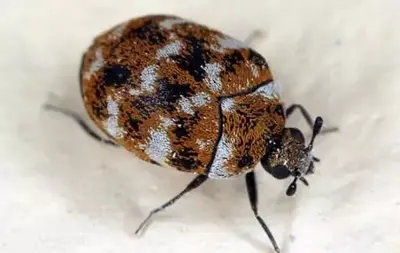
Bat Bugs?
What is a bat bug? Bat bugs are like cousins to bed bugs. It is less common to find these in your home because they are only found around bats. If you are finding bed bugs on near the attic and not in the normal locations like your bed, and you may have bats in the attic then it's possible you are actually dealing with bat bugs. Treatment is basically the same with one exception - you will need an exterminator to remove the bats and seal the entry points. Bat bugs look almost identical to bed bugs without magnification.
Bat bug vs bed bug:
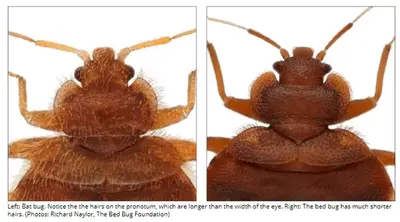
Inspection
If you aren't sure you have bed bugs, or only found a single bed bug you will need an inspection. You can attempt to do this yourself but it will be difficult to find the bed bugs especially early on. If you have seen 2 or more bed bugs you don't need to do inspection - you need extermination. It is extremely likely there are more hiding in your home.
Where are Bed Bugs Found?
Bed bugs are found in hotels, dormitories, apartments, theaters, hospitals, nursing homes, schools, homes... pretty much anywhere people sit or sleep.
Initially bed bugs will be located about 5-7 feet from where you sleep and sit. They like to stay hidden in dark spaces, and can crawl into any space a razor blade can fit. Bed Bugs are extremely difficult to find initially. Many people have them for 1-3 months before they notice them. As they hitchhike on you they will spread to other areas. A home that goes untreated for years can have bed bugs throughout the entire home.
Where to Look:

If you suspect you have bed bugs, make a weekly habit of checking your bed. Mattress tufts and folds and cracks and crevices on the bed frame and headboard are the most likely areas to find initial bed bugs. Once a month inspect more obscure places like baseboards, wallpaper edges, outlet and switch plates, and corners of picture frames near your bed. Look for bugs, shed skins, and excrement.
Inspecting mattress seems:
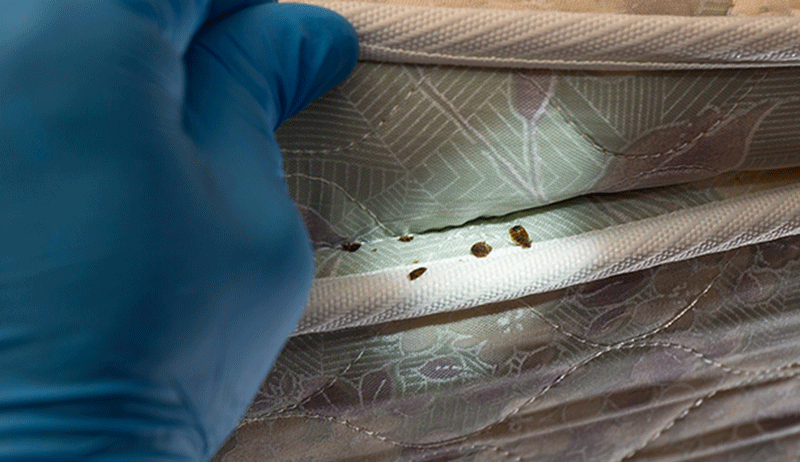
Signs of Bed Bugs:
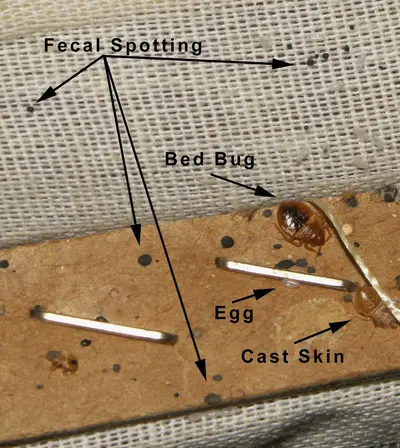
When to get help?
Unfortunately until you have a large enough infestation it is extremely hard to find bed bugs. Even a trained exterminator is only 30% accurate when inspecting visually. If you haven't found anything but still suspect you have bed bugs the best option is to have a k9 bed bug inspection. Specially trained dogs and handlers can quickly inspect your home. Certified dogs are 98% accurate and can find single bugs and bed bug eggs.
K9 Inspection:

Preparing for Treatment
It's important to prepare for treatment. Being prepared makes it easier for your exterminator to do there job - getting your home bug free asap. Every company has a different process and uses different products. You will want to follow the specific instructions given by your exterminator. Some companies have you empty dressers and closets and bag all clothing - that's a lot of work.
There are many types of treatments offered by different exterminators. Whatever treatment you choose, be sure the company is experienced with bed bugs and they offer you a minimum 3 month warranty.
After Treatment
Don't spray any chemicals after your treatment. This could interfere with the treatment and may even void your warranty. Check with your exterminator, as some chemicals can be ruined even by alcohol or water.
If you had a chemical treatment, unfortunately you will need to sleep in the bed and use the furniture. Remember bed bugs can lay dormant for over a year without feeding. They will only emerge to feed if they sense your presence.
Different treatments take different amounts of time to work. Your exterminator will tell you how long to wait before calling back to report bugs.
Prevention
Bed bugs are not an enjoyable experience. They are spreading through Ohio. Prevention is much better than dealing with an extermination. You definitely don't want to spend the time and money exterminating them, only to become infested again a few months later.
Bed bugs are easy to bring home. They are in hospitals, movie theaters, used furniture, nursing homes, pretty much anywhere people sit down is a risk. Even the best pesticides will only give you a maximum of 3 months of protection. There are steps you can take after your home is exterminated to prevent getting another infestation.
What Are the Steps to Prevent Bed Bugs?
- Never bring mattresses, bed frames, and furniture found on the street into your home.
- Avoid buying used furniture. If you do, make sure you inspect it thoroughly.
- When traveling, inspect the bed and furniture. Keep suitcases off the floor and bed and inspect them before you leave.
- If you suspect you have been around bed bugs, immediately wash and dry your clothing on hot settings or place it in a sealed bag until you can launder them.
- Seal cracks and crevices around your home. This will help prevent pests and give bed bugs fewer places to hide if you do get them.
- Enclose your mattresses in quality mattress protectors. This will prevent bed bugs from hiding on or in your mattress and box springs. Make sure the cover is labeled as "bed bug proof". Replace the covers if they are ripped. If you suspect there were bed bugs, these covers must remain in place for a minimum of 1 year to be sure they starve.
What is the Ultimate Way to Prevent Bed Bugs?
Following these steps will greatly reduce the chances of getting a bed bug infestation, but reality is it may still happen. The ultimate prevention is to schedule regular preventive treatment with your exterminator.
What to Look for in a Prevention Treatment?
When choosing an exterminator for preventive treatment be sure to get a company that is experienced with bed bugs specifically. They will need to apply pesticides that are designed for bed bugs to the right areas. Make sure your beds and furniture are being treated. If you have had an extermination and you were satisfied, the company that performed it likely offers this service and is naturally the most obvious choice.



